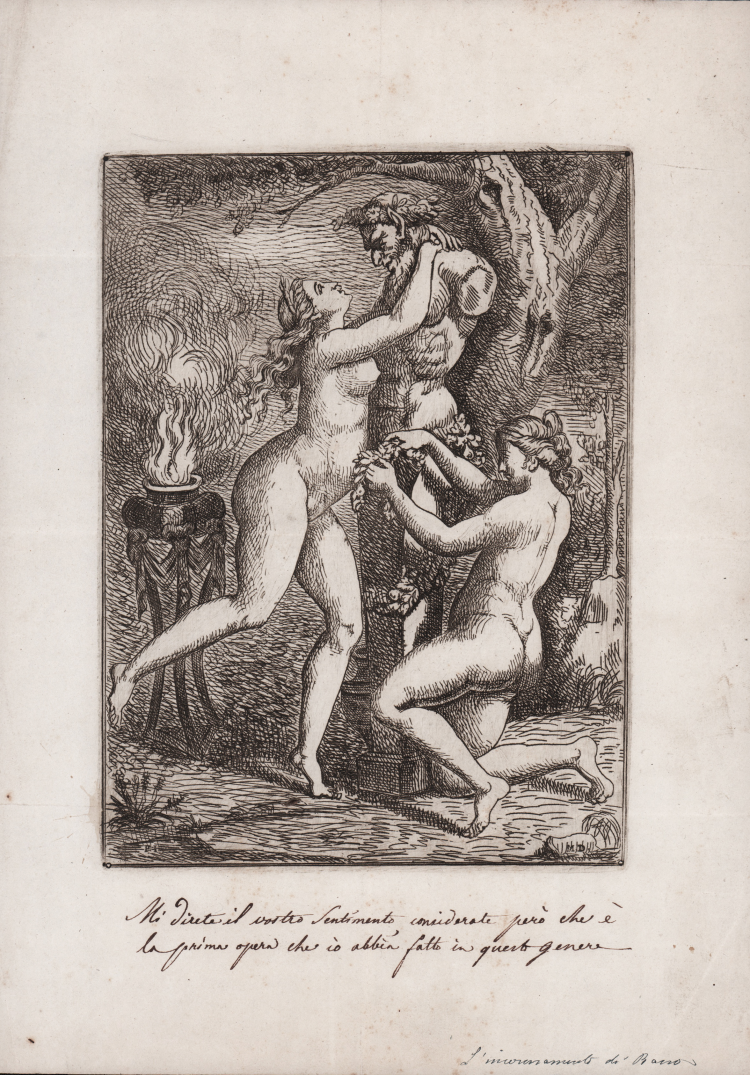




| Reference: | S45134 |
| Author | Anonimo |
| Year: | 1810 ca. |
| Measures: | 140 x 190 mm |



| Reference: | S45134 |
| Author | Anonimo |
| Year: | 1810 ca. |
| Measures: | 140 x 190 mm |
Etching, ca. 1810/20, monogrammed in plate at bottom “P. I.” and “M.D.”
In 1810, in Rome, there circulated clandestinely, without author but engraved by Bartolomeo Pinelli, La scuola di Priapo inventata da Giulio Romano [The School of Priapus invented by Giulio Romano], a series of 20 etchings in which Pinelli reworked sixteenth-century models in keeping with an antique-inspired licentiousness typical of the culture of the time.
The subject could derive precisely from an etching by Pinelli, as suggested by the monogram in the lower left-hand corner, which could be dissolved as Pinelli invenit. However, this work does not reproduce any of the 20 plates that make up The School of Priapus; the subject, although erotically charged with the two completely nude women, is decidedly less explicit. We have not been able to trace the author of the engraving, who is signed with the monogram “M.D.”
In the lower white margin, in brown ink, the author writes: “Mi direte il vostro Sentimento, considerate però che è la prima opera che io abbia fatto in questo genere” [You will tell me your Sentiment, consider, however, that this is the first work I have done in this genre].
We found no trace of this etching in any repertory consulted.
“The series, etched in etching by Bartolomeo Pinelli (the engraver's name is replaced by dots) includes twenty prints of lascivious subject matter freely inspired by the celebrated Modi engraved by Marcantonio on Julian inventions. The resounding scandal caused by this famous series of erotic images offered to the public no longer in a mythological key, but as an uninhibited coupling between a man and a woman, generated at the same time enormous fame to its inventor. Three centuries later, Bartolomeo Pinelli, mindful of Modi's amatory prowess, engraved La scuola di Priapo (The School of Priapus), a lighthearted and provocative exaltation of physical love, where the erotic skills of courtesans become an occasion for irreverent irony on the part of the artist. Interestingly, this early work by Pinelli is met with a similar fate as Giulio's. Raggi relates that the artist, after losing the hospitality offered to him by Abbot Levizzari, had found lodging in the Café in Piazza Sciarra, along with the store assistants. “It was at this time that his misguided wits led him to copy in drawing some unseemly paintings by Giulio Romano and had them sold in the evening by the same garzoni. But since the arts were not born to spoil customs, but rather to civilize and beautify them, the authorities did not take him back. It was this reprehensible license of his early years, in which, however, he took care, in the future, to spend more.” The unseemly prints were, predictably, a huge sales success, but the authorities intervened by admonishing the artist, ordering the seizure of the copies and the destruction of the branches. In the catalog of Pinelli's works, this scandalous series of images is almost never mentioned, while the authorship of the inventions, attributed by the engraver to Giulio Romano, is meant to distance itself from the scabrous subject treated and somehow justify it, calling into question Pippi's prodigious imagination” (S. Massari, Giulio Romano, pp. 349-350).
Anonimo
Anonimo